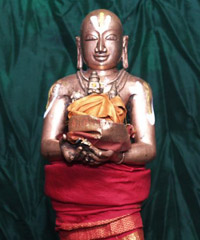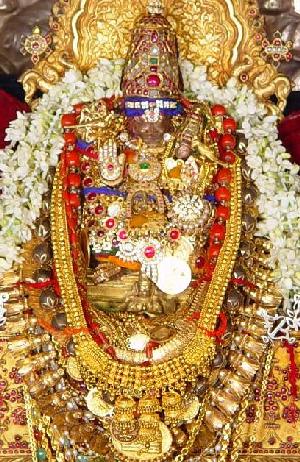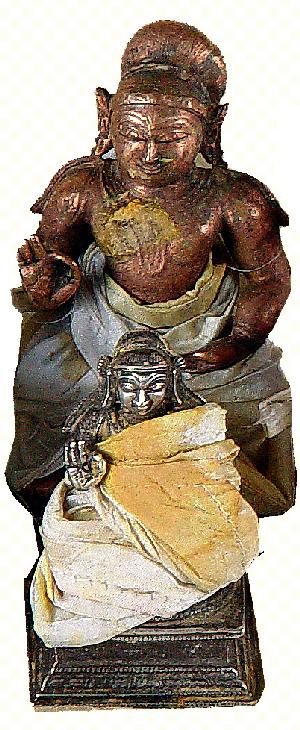Sri Lakshmi Nrishmha Parabrahmane Nama:|
Sri Navaneetha Krishna Prabrahmane Nama:
Sri Satakopaya Nama:| Ramanujaya Nama:|
Sri Nigamantha Maha Desikaya Nama:
Sri Adivan Sotakopa Yatheendra Maha Desikaya Nama: |
Srimate Sri Lakshmi Nrisimaha Divya
Paduka Sevaka Srivan Satakopa Sri Narayana Yatheedra Maha Desikaya Nama
Srimata Srivan Satakopa Sri Ranganatha Yatheendra Maha Desikaya Nama:
Gurubhyastadgurubhyashca namovakamadhee mahe,
Vruneemahecha tatradhyau dampati jagataampati .
Alwar & Acharyas
Alwars are saints who have composed my bhakti songs in praise of Lord Sriman Narayana. There were 12 Alwars including Sri Andal the only woman in the list. The songs of Alwars are codified, complied, tuned and given by Sriman Nathamuni the great Acharya lived in the 8th century. His grandson Sri Alavandar was the model for Sri Ramanuja the greatest Acharya in the Srivaishanva Sampradaya who lived in the 10th century. Swami Desikan is the next important Acharya in the list who lived in the 13th century.
Sri Adivan Satakopa, the founder of Sri Ahobila Muth in the 14th century, was ordained to spread the Saranagati marg through the preaching and make devotees perform them. The latest Acharya, the 45th Jeer, Srimad Azhgiyasingar, the chief of Sri Ahobila Muth is the founder of the Pune temple. The temple has the idols of all these important Alwars and Acharyas as per the Guruparampara. Taking darshan of Acharyas and Alwars, before taking the darshan of Lord, is considered auspicious because the devotees wishes are placed with Acharyas recommendation to Lord and He will not be able to say no to them looking at the highest recommendation they carry.
Devotees should not miss to take darshan of Alwars and Acharya Sannidhi, which is located next to Sri Lakshmi Nrusimhar Sannidhi.
Monthly abhishek is done at the request of the devotees on their respective birth nakshatram days as per details given in this booklet.
Acharya Vaibhavam (Sri Adivan Satakopan)
Place: Kancheepuram
Time: Just before dawn of the day (1398 C.E.).
Young Srinivasacharya, hardly twenty years of age, wakes up in an exciting mood. The dream he witnessed a little while ago is the cause of it. Lord Lakshmeenarasimha of Ahobilam appeared before him, commanding him to come to Ahobilam, don the robe of a sanyasi and be instructed in his future mission of life there. Could this vision be true, he kept asking himself again and again. Ahobilam, of course he knew and worship there is not an unusual occurrence in those days of pilgrimage; but that God should have chosen HIM of all people left him amazed. He went about his morning ablutions as usual but in the same ecstatic mind. He then hurried to his Guru the well known Gatikasatham Ammal and told him of his vision. The old Master also known as Varadavishnvacharya told his disciple Srinivasacharya to obey the mandate. So he wended his way to Ahobilam. Having arrived there, he climbed the hill amidst dense forest (which Thirumangai Azhvar describes as one which none can reach except God), had a dip in the river Bhavanasini and took up abode in that wilderness. Meanwhile Mukundaraya, the local chieftain also reached the, place to receive him on divine command. Lord Narasimha appeared before Srinivasacharya in the form of a sanyasi and initiated him with the "Preshmantra", gave him 'Sanyasa asrama''' and named him 'Satakopa Jeeyar'. Thus was born Sri Ahobila Mutt and its First Jeeyar.

Sri Malolan in the divine hands of
Srimad Athvan Shatakopa Jeeyar
(This Archa Vighraham is in Ahobilam.)
This is commemorated in the following 'mangala sloka'
"Abobile Sri Nrisimhah Prekshamantram swayam dadou
Yogiroopena yasyasmai Satakopaya mangalam "
This incident can be seen now in the form of images, carved on a pillar in the Ranga mandapa of the Lower Ahobilam temple (vide History of the Cult of Narasimha in Andhra Pradesh by Dr. Madabhoosi Narasimhacharya).
Srinivasacharya, son of Kidambi Kesavacharya was born on 18th August 1379 CE at Thirunarayanapuram (Melkote), Karnataka. Being a family of great orthodox views and of high literary cultural attainments, the boy showed a remarkable mental grasp and keen perception and so, his father Kesavacharya, himself a learned man, decided to send him to Kancheepuram to study at the feet of Ghatikasatham Ammal, a very great scholar of those days. The name Ghatikasatham Ammal (grandson of the famous Nadadoor Ammal) was given to this learned preceptor in honour of the fact that he could compose a hundred verses in a Ghatika (Nazhigai). His school was the most famous and sought after during that period and no wonder Kesavacharya decided to put his son Srinivasacharya there so as to make him a brilliant scholar. Srinivasacharya acquired all the knowledge when Lord Lakshmeenarasimha ordained him into the monastic order as mentioned above and gave him the name 'Satakopa Jeeyar'. The Lord commanded him to take any one of the 'Utsava' Moorthis and said the Jeeyar's task henceforth would be,

Sri Malolan of Sri Ahobila Mutham
The Jeeyar though anxious to start on his mission right earnestly, could not decide on the 'Utsava' Moorthi he could take with him. He, therefore, went into a meditation and prayed that the most suitable Moorthi' should come and bless him. Immediately the 'Utsava Moorthi' of Malola Narasimha (Lakshmeenarasimha) came flying from the temple and seated Himself on the outstretched hands of the Jeeyar. Mukundaraya on hearing of this miracle became his disciple and offered not only arrangements for permanent daily worship but also gave a palanquin and other paraphernalia to assist the Jeeyar in his sanchara (tour) along with the 'Malola' Moorthi. He also gave control of all the temples to this Jeeyar and henceforth Ahobila Kshetram came under the direct control of Ahobila Mutt whose pontiffs are even today the hereditary trustees. Now a look at the 'Malola' Moorthi will reveal that He wears a Paduka indicating that He is ready to proceed on tour and thus both the Jeeyar and his God fully equipped commenced their historic travel giving spiritual and material succour to all who prayed in the course of their travel. Bearing the name Satakopa as he was, it was natural that this first Jeeyar should be eager to visit Alwarthirunagari the holy place sacred to Nammalwar. Having reached Alwarthirunagari, he found to his dismay and grief that the temple of Nammalwar was completely changed to one wherein eleven images of siva (linga) had been installed and had come to be called Ekadasarudra Kshetra. The idol of Nammalwar was not to be found anywhere.
 Nammazhvar
Nammazhvar
Setting up his camp there, Satakopa Jeeyar went about his routine of preaching the doctrine of surrender (prapatti) and gradually his fame spread as a mystic saint of great powers and efficacy. Distressed at the loss of Nammalwar and his shrine, he constantly recited Madurakavi's stanzas when Nammalwar appeared before him in a vision, told him that his idol lay in the bed of a river adjacent to a ravine and that the Jeeyar should recover and restore it. It so happened that the Pandya King of that place was on a hunting trip around those parts and the Jeeyar's divine personality instantly attracted him. He fell at the Jeeyar's feet and solicited to become a convert to Vaishnavism. Accompanied by this king, the Jeeyar went to the spot of the difficult terrain and prayed to Nammalwar and lo! the image slowly emerged from the river bed and settled on the outstretched arms of the Jeeyar just as 'Malola' Moorthi had done so earlier!! The King was spellbound and without hesitation, (on the orders of the Jeeyar), he straightway removed the saivite images and installed the Nammalwar's idol in the temple as before with due pomp and favour thus restoring the temple's pristine Vaishnavite glory. The British historian Mr. Sewell's list. of South Indian Dynasties cull out one Kulasekhara Pandya as the reigning chief of this period (vide History' of the Ahobila Mutt by S.N. Venkatesa lyer).
But the fact remains that the Pandya king whoever he was had built Mandapams etc., at the temple and also made other arrangements for worship at the instance of the first Jeeyar. The mandapam and other structures stand even today on the banks of the river Tamraparani as also a shrine for Vedanta Desika constructed by this saint. The king so adored this Jeeyar that he made a true image of this Adivan Satakopa Jeeyar and had it duly installed in the Nammalwar shrine 'in Alwarthirunagari. Pleased with the loving service of this Jeeyar, Nammalwar gave him the name Adi (first), Van (powerful) Satakopa (Nammalwar's own name) by which the Jeeyar came to be called. Henceforth the successive Jeeyars have always the prefix "Van Satakopa". Vedanta Desika for his part gave this Jeeyar the suffix Mahadesikan as also the various titles (i) Srimat Vedamarga Pratishtapanacharya, (ii) Paramahamsa Parivraajaka, (iii) Ubhaya Vedantacharya, (iv) Sarvatantra Swatantra and (v) Bhagavat Ramanuja Siddhanta Nirdharana Sarvabhouma. It will be significant to note that even today, whenever and wherever the Jeeyars go, the air resounds with the cries of these names chanted loudly by the followers of the mutt. Suffice it to say that Yateendra (best of saints) applied very appropriately not only to this Jeeyar but to every successive Jeeyars. This term is not applied to any other holy order of which there are many.
This Pandyan King's incident was heard by King Mukundadeva Raya of Orissa who was wandering in wilderness, having lost his kingdom to the Muslims. Keeping himself abreast of the times, the Jeeyar felt it was expedient to come to the rescue of this exiled monarch who had sought his help. The Guruparampara describes the miracle of the pride of lions (Remember that Man-lion manifestation of God) invaded Orissa and put to flight the philandering Muslims who in sheer fright handed back the kingdom to Mukundadeva Raya and fled never to return. While the Jeeyar was admiring the ways of his pet God Narasimha, the King fell at the feet of this Jeeyar in great gratitude and accorded him all honours befitting the occasion (vide history of Ahobila Mutt by S.N. Venkatesa lyer). It is specially mentioned by the 7th Jeeyar in his famous samskrit drama 'Vasantika Parinayam'. Taking leave of the Orissa King, the Jeeyar, Sree Adivan Satakopa Yateendra Mahadesikan then proceeded towards Vijayanagar Kingdom whose Rajah received him with full honours and gave him grants and presents. It was at this time that one Manappakkam Thozhappar became the Jeeyar's disciple getting Panchasamskara as also expert knowledge in Sreebhashyam, Bhagawad Vishayam and Rahasyatrayasaram at the Jeeyar's feet. Marveling at the wisdom and learning of this Thozhappar, the Jeeyar asked him to write authoritative text on various Sastras which Thozhappar did under eight different heads earning the deserving title 'Vaidika Sarvabhouma'. As the head of the 74 Simhasanadhipathis, this Jeeyar Adivan Satakopa then trekked his way to Thirukudantai (Kumbakonam) to worship Lord Aravamudhan and then proceeded further south to Nammalwar's place where he constructed a Mutt with all conveniences for the benefit of Srivaishnavas. From here the Jeeyar went to Thirunarayanapuram (Melkote) where after worshipping Ramanuja, Selva Pillai and Yadugiri Nachiyar, he set up a camp on the banks of the Kalyani Pushkarani where he taught Sreebashyam and Rahasyatrayasaram to many Srivaishnavas.. One day, people beheld the wonder of a five-headed serpent spreading its hood and listening to the exposition of the Jeeyar's lucid interpretation of Ramanuja's philosophy. The class was not perturbed and at the end of the session, the serpent glided slowly and disappeared. That Ramanuja was the incarnation of Adisesha impressed heavily on the audience who with one voice agreed that Ramanuja Himself gave darsan now in the guise of a serpent and gave his approval of Jeeyar's interpretations!
The King of those parts sought the Jeeyar's benediction to get rid of his ailment and lo! his cure came as soon as he renovated the Rajagopuram of the Thirunarayanapuram Ternple at the instance of the Jeeyar, who also installed the Vigraha of Vedanta Desika there. In fulfillment of the desire in a vision of Lord Venkatesvara, the Jeeyar then went to Thirupathi and camping there for sometime, he built a Mutt both at Thirumala and Thirupathi, where idols of Lakshmeenarasimha were consecrated by him. He also provided steps to climb the Thirumala Hills and constructed several Mandapams on the way so that the pilgrims could rest while negotiating the steep climb. The jiyar then reached Kancheepuram where he built a 1,000 pillared Mandapam in the Varadaraaja swami Temple and even now, one can witness a Lakshmeenarasimha image in one pillar opposite to which is the figure of the Jeeyar in another pillar. It is said that this mandapam was, constructed from out of the wealth surrendered to the Jeeyar by a scholar by name Udayabhanu Misra who lost to the former in vedantic debate. It seems this debate lasted nearly a fortnight when Vedanta Desika appeared to the Jeeyar in a vision and told him to deal the matter by referring to his (Desika's) treatise Sathadooshani, with the result Udhayabhanu accepted defeat and became a disciple of the Jeeyar, who also built a frontal Mandapam and temple for Deepa Prakasa at Thooppul and also a mandapam and Sannidhi for Vedanta Desika whose idol was also duly installed there. After all this, the Jeeyar took the road towards Sholingar visiting Thirupathi on the way again and then proceeded to Sriperumbudur, the birthplace of Ramanuja. From there he found his way straight to Srirangam where he was received with full honours given to the prince among ascetics. Never was the reception so spontaneous as was given here. Staying in this holy city, he renovated the saptaprakara walls as was done by Thirumangai Azhwar earlier and Jataavarman Sundarapandya a little later. At the northern entrance of the temple, he constructed his mutt wherein the idol of Lakshmeenarasimha as also his own image were installed. Then on divine command, he built a frontal mandapam at Dasavatharam Sannidhi (built by Thirumangai Azhwar). Again as per Ranganatha's wishes, he built a Sannidhi for Vedanta Desika in front of the Srirangam Nachiyar Sannidhi and made arrangements for the daily worship there. The northern Gopuram was built at his instance where his image can be seen even today. He also constructed a mutt at the eastern gate of the Uttara Street duly consecrating an icon of Lakshmeenarasimha. Having thus given fixity and method to the activities, the Jeeyar was called upon to go to Melkote for the worship of Thirunarayanan.
It is significant after that sixty years of divine service in his Sanyasa asrama', and at an advanced age, the Jeeyar should come back to his place of birth where he shed his mortal frame so as to be in the constant company of Sreeman Narayana in Sreevaikunta. This happened in April 1458 C.E. and his Brindavan in Melkote is a beacon light to his followers even to this, day. He was succeeded by the eminent Nambakkam Swami Srivan Satakopa Sriman Narayana Yateendra Mahadesikan.
45th Srimad Azhagiyasingar

1926 - 2013
His Holiness, the 45th Jeer of Sri Ahobila Muth, Srimathe Sri Lakshminrisimha Divya Paduka Sevaka Srivan Satagopa Sri Narayana Yathindra Maha Desikan, ascended to Paramapadham at 12:05 AM Indian Time, Sunday May 19th 2013.
46th Srimad Azhagiyasingar

By the divine order of Sri Lakshmi Nrusimhan, the Pattabisheka Mahothsavam of HH 46th Jeer of Sri Ahobila Mutt, Srimathe Srivan Sathakopa Sri Ranganatha Yatindra Mahadesikan was held in a grand manner on Thursday 23th May between 8.30 to 9.30 am at Sri Dasavathara Sannidhi, Sri Rangam, (Vijaya Varusham,Vaikasi 9th, Miduna Lagnam, Swathi Nakshatram).
Sri Devanar Vilagam U.Ve. Anantha Padmanabhachar has been appointed as the Sri Karyam of Sri Matam on this occasion.
